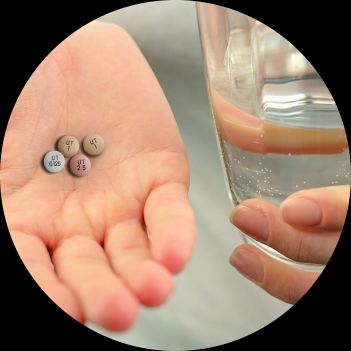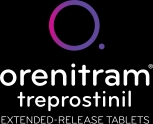Important Safety Information for Orenitram
Who should not take Orenitram?
Do not take Orenitram if you have severe liver problems.
What should I tell my healthcare provider before taking Orenitram?
Tell your healthcare provider:
- If you have liver problems or diverticulosis.
- If you are pregnant, breastfeeding, and/or plan to become pregnant or breastfeed. It is not known if Orenitram will harm your unborn baby or if Orenitram passes into your breast milk. Talk to your healthcare provider about the best way to feed your baby during treatment with Orenitram.
- About all the medicines you take, including prescription and over-the-counter medicines, vitamins, and herbal supplements. Orenitram and other medicines may affect each other causing side effects. Do not start any new medicine until you check with your healthcare provider. Especially tell your healthcare provider if you take another medicine that contains treprostinil, such as Remodulin® or Tyvaso®.
What is Orenitram?
Orenitram is a prescription medicine used to treat pulmonary arterial hypertension (PAH) which is high blood pressure in the arteries of your lungs. Orenitram can help slow down the progression of your disease and improve your ability to exercise. It is not known if Orenitram is safe and effective in children.
How should I take Orenitram?
- Do not change your dose or suddenly stop taking Orenitram without first talking to your healthcare provider.
- Orenitram is usually taken 3 times a day (about every 8 hours) or 2 times a day (about every 12 hours). Your healthcare provider will tell you how often you should take Orenitram. If you have side effects, your healthcare provider may tell you to change your dose or when you take Orenitram. Take Orenitram with food.
- Swallow Orenitram tablets whole. Do not split, chew, crush, or break your Orenitram tablets. Do not take Orenitram tablets that are damaged or broken. If Orenitram tablets are not taken whole, they may release too much medicine at one time. This can lead to side effects.
- If you miss your dose of Orenitram, take the missed dose as soon as possible with food.
- If you miss 2 or more doses of Orenitram, call your healthcare provider to see if you need to change your dose.
- If you take too much Orenitram, call your healthcare provider or go to the nearest hospital emergency room right away.
- You may see the tablet shell in your stools (bowel movements). This is usually normal. The tablet shell is not digested. If you have diverticulosis, the tablet shell may get stuck in a blind pouch or diverticulum in your intestine.
What are the possible side effects of Orenitram?
Orenitram can cause serious side effects, including worsening of PAH symptoms.
- Stopping Orenitram suddenly may cause worsening of your PAH symptoms. Do not change your dose or suddenly stop taking Orenitram without first talking to your healthcare provider.
- The most common side effects of Orenitram include headache, diarrhea, nausea, vomiting, flushing, and pain in arms, legs, and jaw. These are not all of the possible side effects of Orenitram. Tell your healthcare provider if you have any side effect that bothers you or does not go away.
- Call your healthcare provider for medical advice about side effects. You may report side effects to the FDA at www.fda.gov/MedWatch or call 1‑800‑FDA‑1088.
What is Orenitram?
Orenitram is a prescription medicine used to treat pulmonary arterial hypertension (PAH) which is high blood pressure in the arteries of your lungs. Orenitram can help slow down the progression of your disease and improve your ability to exercise. It is not known if Orenitram is safe and effective in children.
The risk information provided here is not comprehensive. To learn more about Orenitram, talk with your healthcare provider.
Please see Full Prescribing Information and Patient Information at www.orenitram.com or call Customer Service at 1‑877‑UNITHER (1‑877‑864‑8437).
OREISIconOCT19















